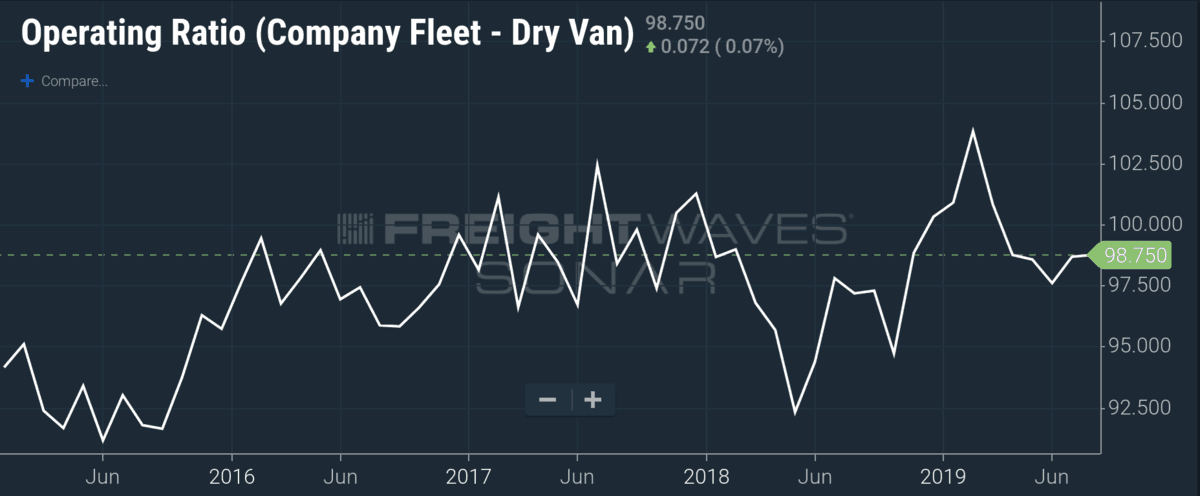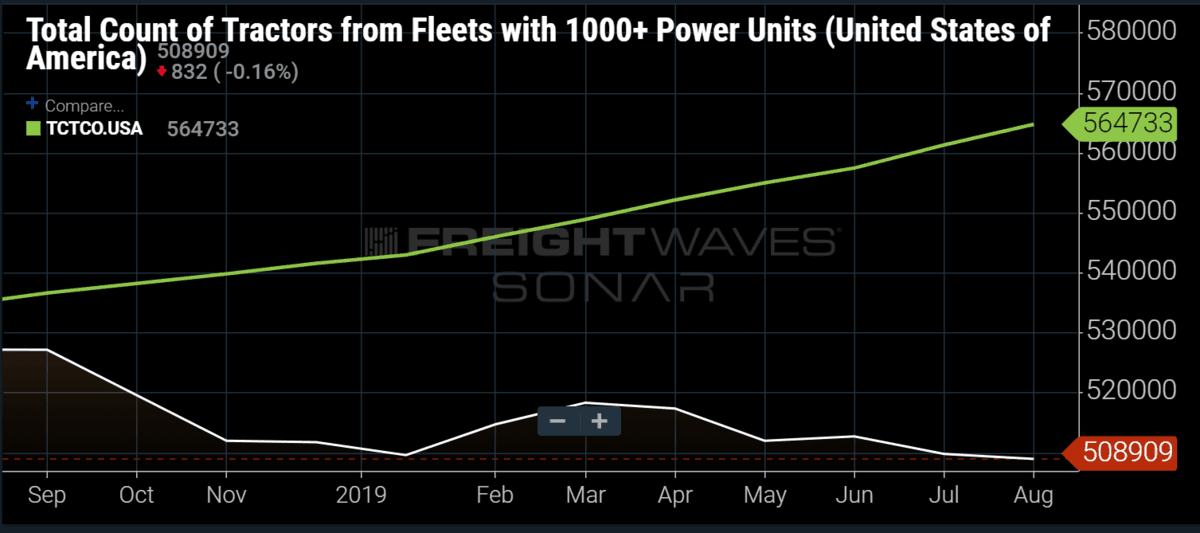
Chart of the Week: Operating Ratio — Dry Van Carriers Company Fleet (SONAR: OPRAT.VCF)
Like travelers walking through the desert that found an oasis, carriers found a wellspring of freight in 2017 and 2018 and expanded their operations. Unfortunately for the carriers, the pool has dried, leaving many dying of thirst. 2019 has been a lesson in how trucking markets can overheat just like the economy, leading to an uncomfortable period of contraction. Operating ratios (ORs) for dry van carriers in the Truckload Carriers Association (TCA) Truckload Indexes program have averaged over 100% since the start of the year as a result of this contracting growth.
In recent weeks there has been a lot of dispute in the media and over Twitter about the state of the trucking market. We’ve described the market as getting “bloody” earlier this year, while others have talked about how “strong” the trucking business is. Recently, we developed a view that the market was about to turn for the better, based on volume data we have seen in the market.
Regardless of the words you use, it is important to inform these views with data. The TCA benchmarking program is the first and only program in the history of truckload that provides monthly benchmarking of hundreds of competitive truckload carriers, ranging from mid-size to enterprise (smallest fleet 75 trucks, largest is 7000). In total, 73,000 trucks are counted in the data sample, representing 8% of the total truck count of medium and large trucking fleets operating in the entire U.S.
The fleets submit monthly financial data into a benchmarking software program that compiles aggregated financial reports for the industry, sliced by a number of variables. While the truckload carriers submit 500+ points of data, only 31 are published in an aggregated basis inside of SONAR. With this data we can use data and not bias to determine how the industry as a whole are doing. Prior to the data being offered on an aggregated basis, the only data points non-insiders would get about the state of the market is through the public truckload carrier earnings reports that would come out quarterly and offer up 8-10 operational KPIs. Now we have over 30 and they come up out monthly from over 200 different fleet profiles.
Operating ratios are a measure of operational efficiency. The formula is operating costs/operating revenue. A 100 OR indicates that for every dollar made in revenue, 100% of it goes to funding the cost of doing business, leaving nothing for debt or investment. In trucking operating costs are things like driver wages, back office support, and maintenance costs. Debt and interest payments are not included in these costs.
Most carriers carry some amount of debt in order to fund some of their growth as many trucking companies are low on cash. Purchasing equipment and buildings are some of the more commonly financed items. In general, many carriers consider making five to ten cents on the dollar a success, or a 90 to 95 OR.
The issue for carriers in 2019 has been more about the oversupply than the lack of demand, although both are present. As carriers saw margins expand in 2018, they decided to invest in growing their fleets as was demonstrated by the record number of class 8 truck orders last year. About the time that most of the orders were being placed the market started to cool. Daily truckload volumes have averaged roughly 3% under 2018 from March through July, but the most brutal hit came in May and June when they were over 4% under previous year volumes.
So far in 2019 over 600 trucking companies have reportedly failed with two larger carriers closing this week. The first carrier, HVH transportation, was owned by a private equity firm and had over 300 trucks. The second was a smaller 100 power unit operation in Georgia.
The trucking industry is extremely competitive with relatively low barriers to entry. All it takes is a commercial driver’s license (CDL), a truck, and a willingness to drive to start a trucking company. Many drivers will quit larger operations to start their own venture after a time. FreightWaves has studied the Federal Motor Carrier Safety Administration (FMCSA) data and found that smaller fleets are still growing when the lager fleets (100+ trucks) have contracted over the past several months.

Many of these drivers have developed relationships with shippers over the years, making them a reliable option. Smaller carriers have lower overhead costs and can drop rates under the larger carriers whose costs are filled with building leases and back office costs. The influx of smaller carriers has a deflationary impact to both spot and contract rates.
In 2017, carrier ORs averaged 99%. Many of the contracted rates were made based on 2016 activity, which was the last freight recession. Seeing as most freight contracts are made on an annual cycle, these rates were in place throughout most of 2017 and early 2018, which kept profit margins low.
Late in 2017 into early 2018, carriers started falling out of their contracted obligations to service higher paying spot market freight. Demand grew so fast that spot rates were well above contract. Carriers, at times, could get more than double the price of hauling for their contracted shippers. The spread between spot and contract was too much to ignore.
Recently, volumes have recovered but have not had significant impact to rates. This should provide relief for some carriers and extend their life for a time, but winter is coming when freight volumes typically plummet. Carriers normally build reserves in the summer to keep them afloat during the slower months. The true test of carrier resolve has yet to come.
About the Chart of the Week
The FreightWaves Chart of the Week is a chart selection from SONAR that provides an interesting data point to describe the state of the freight markets. A chart is chosen from thousands of potential charts on SONAR to help participants visualize the freight market in real-time. Each week a Market Expert will post a chart, along with commentary live on the front-page. After that, the Chart of the Week will be archived on FreightWaves.com for future reference.
SONAR aggregates data from hundreds of sources, presenting the data in charts and maps and providing commentary on what freight market experts want to know about the industry in real time.
The FreightWaves data science and product teams are releasing new data sets each week and enhancing the client experience.
To request a SONAR demo click here.












Elvis Durant
Pretty simple….TARIFFS! Take it or leave it! Im in the flatbed department and steel/aluminum tariffs killing the flatbed market…….
RAMON
We must get together as owner operators and not run for under two dallors for no one but it a losing battle we are being taking out one buy one now person will ever come together in the same fight it’s a lost cause
Chris
Exactly when u got all these foreigners entering this business and
Hauling cheap fright I see it all the time. I quit running the road I don’t see how u long haul drives are making money!!! All that time in a truck and not getting paid to sleep in in!! F that l!! I run local and make twice as much as u long haul guys
Brian Ristau
The biggest issue are people claiming to be owner ops yet lease on to large carriers. You as a lease operator help them fund the cheaper rates because you eliminate their overhead whenever you haul one of their loads. They act as if tour getting the best deal an in actuality if you became fully independant could increase your profit margins 20% and as well find that your not getting such a great deal on insurance. Im 100% independant insurance is less than 8k a year, im not restricted to speed limitations so my engines run at optimum performance. Age of equipment is also not an issue so i can run elog and emmision exempt trucks which both eat inton the bottom line. The tax breaks have defineatly incentivized small business.
Ken Davis
Yep know your number.
Lawn care King
Torres
Sounds like a bunch of BS to me . quite trying to blame trump too . high fuel costs and poorly managed truck companies…is the problem..
Bryan McGaugh
Ok as usual truckers fighting truckers! I hear it all the time “if the wheels don’t turn you don’t earn”spoken like a true ass kisser hauls anything just to make a dime and that keeps the rates low…don’t haul the crap! I deadhead home 300 miles out of Texas because of cheap freight. I ran Texas 7 years for Watkins and never saw rates like this! As long as the truckers keep pulling that crap it will never change. Some rates are so low .80cpm it doesn’t make sense to own a truck! Then you have the trucking companies that own their brokerage firm so the rates get cut twice some don’t have a fuel surcharge. So complain about Donald Trump it whatever ethnic group or China but it’s not them it’s cut throat business and we are a bunch of idiots that keep putting up with it! Staying gone from families and friends working for people that don’t care about you as long as you run and stay out 3 or 4 weeks sleep in a truck while they go home every night to their family and enjoy what we do for them but are never fair with us!! It’s our fault no one else’s so just shut up sit down and drive or stop hauling cheap freight and watch the rates go up!!
Cedrick Smit
Stop blaming other people for your inabilities! Remember when the wheels don’t turn, you don’t earn!!
Malik
Dis agree with the statement above..thats happening jus because of competition in nidding reace of RPM.there are many new brokers that dont know how to bid .they become brokers just by watiching YOUTUBE HOW TO VIDEOS.
Only in 2019 FMCSA has approved and issued 21000 new broker authorities.
Goranac
If wasent for big expenses payments insurance etc.than this would be okay otherwise I as Truck owner struggle with the Market on top of that no Home time .
Cruz
It’s all about president Donald Trump arancels restrictions on other countries policies
Bill Hinds
Quit your f-ing crying, if you are not making money know it’s because of your business practices. Less trips to Vegas and Cancun. Sell your trucks and let the Cubans take over the trucking Industry. If you are not making money in today’s trucking Industry it’s because You are not up to the tasks.
Luis Ponce
The Cubans take over? What a stupid statement! You have the Russians the Indians making commercials living large wile in Fl we are trying to get out of the state. Blame all the big companies with their team ahead labores team driver the rail road. Cubans are scaling their trucks and getting out of business wile some idiot like yourself try to blame other. Blame you president that sold the industry to the truck manufacturers the big companies and his stupid war with China and stop talking sht
Bill Hinds
It’s Trump it’s Trump.
Look in the mirror. It’s You
Elvis Durant
Trump! Pretty simple! Read that line…..600 carriers failed so far in 2019…..Seems you like skipped reading that paragraph!
art
Dont be dumb.
Too many truckers again undercutting each other. Never ending cycle.